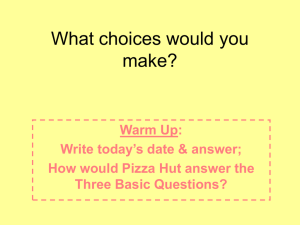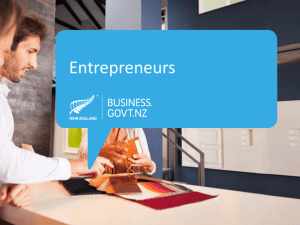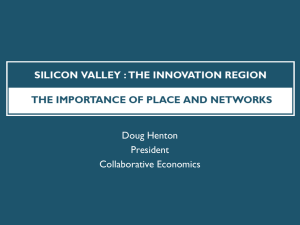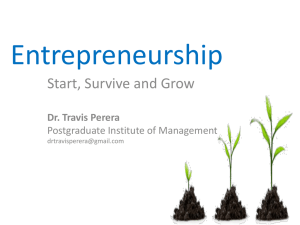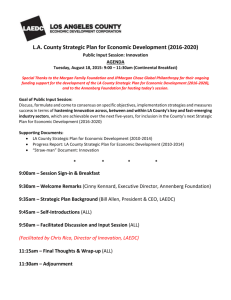Finding and Developing New Product Ideas: An Ideation Process for
advertisement
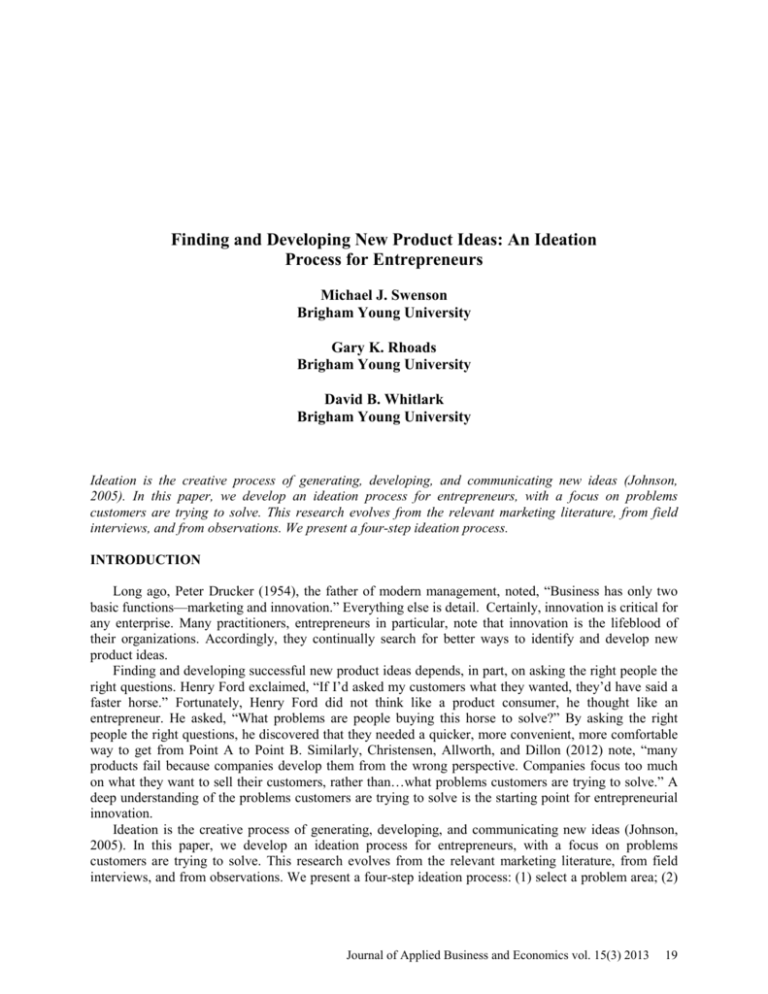
Finding and Developing New Product Ideas: An Ideation Process for Entrepreneurs Michael J. Swenson Brigham Young University Gary K. Rhoads Brigham Young University David B. Whitlark Brigham Young University Ideation is the creative process of generating, developing, and communicating new ideas (Johnson, 2005). In this paper, we develop an ideation process for entrepreneurs, with a focus on problems customers are trying to solve. This research evolves from the relevant marketing literature, from field interviews, and from observations. We present a four-step ideation process. INTRODUCTION Long ago, Peter Drucker (1954), the father of modern management, noted, “Business has only two basic functions—marketing and innovation.” Everything else is detail. Certainly, innovation is critical for any enterprise. Many practitioners, entrepreneurs in particular, note that innovation is the lifeblood of their organizations. Accordingly, they continually search for better ways to identify and develop new product ideas. Finding and developing successful new product ideas depends, in part, on asking the right people the right questions. Henry Ford exclaimed, “If I’d asked my customers what they wanted, they’d have said a faster horse.” Fortunately, Henry Ford did not think like a product consumer, he thought like an entrepreneur. He asked, “What problems are people buying this horse to solve?” By asking the right people the right questions, he discovered that they needed a quicker, more convenient, more comfortable way to get from Point A to Point B. Similarly, Christensen, Allworth, and Dillon (2012) note, “many products fail because companies develop them from the wrong perspective. Companies focus too much on what they want to sell their customers, rather than…what problems customers are trying to solve.” A deep understanding of the problems customers are trying to solve is the starting point for entrepreneurial innovation. Ideation is the creative process of generating, developing, and communicating new ideas (Johnson, 2005). In this paper, we develop an ideation process for entrepreneurs, with a focus on problems customers are trying to solve. This research evolves from the relevant marketing literature, from field interviews, and from observations. We present a four-step ideation process: (1) select a problem area; (2) Journal of Applied Business and Economics vol. 15(3) 2013 19 explore the specific problem; (3) propose and test alternative product ideas; (4) perfect the top product idea. SELECT A PROBLEM AREA Begin by considering the problems customers are trying to solve. Gather data on where there is pain in the market. Find the pain by observing customer frustration first-hand. We note two generic approaches for selecting problem areas—(1) broad and opportunistic or (2) narrow and focused. With the broad approach, entrepreneurs consider customer pain points with no particular product category in mind. These opportunistic entrepreneurs look for big market opportunities, then uncover the associated pain points and sell a solution. For example, if they see a big market for cell phones that scratch or damage with use, then they sell protective cases for cell phones. Opportunistic entrepreneurs use engaged observation with potential customers to identify problem areas by encouraging discussion with the following statements and questions: 1. Name some great products that have some annoying little problems. 2. Describe some bad or annoying service experiences you’ve had recently. 3. Over the past year, which product purchases have you regretted the most? Problem areas emerge as customer pain points are identified. Conversely, with the focused approach, entrepreneurs leverage their expertise or passion in a specific product category or industry. They search familiar landscapes for pain-points in their specialty area. For example, if they have a passion for scrapbooks, they invent problem-solving scrapbooking tools, paper, cards, and accessories. These entrepreneurs engage potential customers with specific questions/statements such as: 1. What keeps you from really enjoying [product]? 2. If you could change one thing about [product], what would it be? 3. I know it is not possible with [product], but wouldn’t it be wonderful if [product] could … For entrepreneurs, the bigger the problem area, the bigger the opportunity. We classify these opportunities into three categories: (1) solve everyday pain; (2) ride waves of interest; and (3) stretch or entertain to the extreme. Both opportunistic and focused entrepreneurs can address hard-to-ignore pain points that most people experience every day. The pain point must have enough intensity so that potential customers have (1) strong reason to believe the product claim and (2) strong willingness to overlook the risk associated with purchasing a new product from a relatively new company. Riding the coattails of successful products provide big opportunities for entrepreneurs. For example, the popularity of Crocs shoes makes possible the success of Jibbitz decorative shoe buttons. The popularity of iPhone makes possible the success of apps like Angry Birds and accessories like Zagg’s InvisibleShield. Tapping into engaged buyers that are already on the lookout for ways to make their favorite products even better enables entrepreneurs to ride the waves of interest. Stretching an idea to the extreme or entertaining to the extreme provides additional opportunities for entrepreneurs. For example, energy drinks succeed because they take the energy benefit of cola drinks and stretch it to the extreme. 5-hour Energy Drink succeeds because it stretches the energy benefit even more by eliminating the extra-calorie distraction. Good ideas also entertain to the extreme. The JetLev water-propelled jetpack shoots out twin streams of water that will keep 500 pounds airborne, move a person across the water’s surface at 22 mph and send one over 30 feet in the air. This extreme fun supports an extreme price tag. While vacationers spend upwards of $250 for 90 minutes of instruction and flying time, celebrities have spent $5,000 for an afternoon of jetpack entertainment. 20 Journal of Applied Business and Economics vol. 15(3) 2013 EXPLORE THE SPECIFIC PROBLEM After identifying the problem area, probing, open-ended questions are used to deep dive into the pain and identify product attributes that address the core problem. The objective is to detect customers’ desired functional and emotional outcomes. Furthermore, outcome barriers are revealed in this exploration mode. With this information, product requirements begin to emerge. The big question for entrepreneurs is “How do customers measure value?” Laddering research method provides a means to answer this question by identifying the linkages potential customers make between product attributes and personal benefits (Reynolds, Dethloff, and Westberg, 2001). Specifically, the method enables researchers to identify customer’s personal outcomes, both functional and emotional, along with the barriers that prevent the desired outcomes and attributes that lead to the desired outcomes. 1. What outcomes (functional and emotional) are customers seeking? 2. What barriers stop those outcomes? 3. What attributes lead to those outcomes? The Case of Prescription Drug Containers Consider the typical brown or white containers for prescription drugs. They all look the same, yet they are different: label size, label position, text font, information positioning, amount of information, and format of instructions. These differences from bottle to bottle and from pharmacy to pharmacy can cause confusion, and confusion can cause medication errors. Of course, medication errors and even the anxiety over the possibility of making such errors can cause pain—the problem area. Figure 1 delineates the process for identifying how customers measure value. With this information, graphics designer Deborah Alder and industrial designer Klaus Rosburg turned the traditional prescription drug bottle on its head so that the label could be wrapped around the top (Rhoads, Swenson, and Whitlark, 2010). Then they flattened the container so patients could read the label without rotating the container. The label is divided into primary and secondary information. Colored rubber rings attached to the neck of the bottle enable family members to identify their own medications to minimize confusion among household members. Today, this problem-solving prescription bottle minimizes confusion and reduces pain for many Target pharmacy customers across the United States. FIGURE 1 EXPLORE THE SPECIFIC PROBLEM--PRESCRIPTION DRUG CONTAINERS 1. What outcomes are customers seeking? Journal of Applied Business and Economics vol. 15(3) 2013 21 2. What barriers stop those outcomes? 3. What attributes lead to those outcomes? PROPOSE AND TEST ALTERNATIVE PRODUCT IDEAS Propose and compare alternative product ideas with potential customers using Wow Groups (Rhoads, Swenson, and Whitlark, 2010). To illustrate this concept, we note the experience of Ken Hakuta, founder of the Wacky Wallwalker. When he was asked how he knew that the Wacky Wallwalker was going to be a hit he answered, “It’s really pretty easy. I show people the new product and look to see if they tilt their head slightly and say WOW!” He continued, “If they do, I’ve got another hit.” Although we believe this is a useful starting point for testing product ideas, a deeper understanding of the meaning behind the WOW provides richer test information for alternative ideas. To understand meaning behind WOW responses, we use a framework proposed by Edward de Bono, the Six Thinking Hats (1985). The framework provides a means for potential customers to be creative in seeing the total picture when discussing and evaluating product ideas. Each thinking that addresses a different activity carried out in what we call a WOW! Group to distinguish it from traditional focus groups often used in marketing research. Briefly, the Six Thinking Hats are: 22 Journal of Applied Business and Economics vol. 15(3) 2013 White: Facts about the product, service, or people who might use them Red: Emotional reaction to the product or service Yellow: Perceived benefits or positive support for the product or service Black: Perceived shortcomings or objections to the product or service Green: Creative thoughts around improving the product or service Blue: Summary thoughts regarding the WOW! Group process and results When testing alternative product ideas, we invite 10-12 people from the target market to participate in the WOW! Group. We begin with the White Hat by describing the facts of the product. Next, using the Red Hat, we ask participants, “How would you rate this product from 1 to 10, where 1 means the product is just okay and 10 means WOW! Here is my credit card!” We look for average ratings at 7 or above. Then we ask group members to describe the perceived benefits (Yellow Hat) followed by perceived shortcomings (Black Hat). Next, creative thoughts about improving the product are solicited (Green Hat). We conclude by asking for summary comments and observations (Blue Hat). Using the Six Thinking Hats creates an opportunity for entrepreneurs to bring together 10-12 people from the target audience, introduce several product concepts, compare concepts fairly without leading participants, identify key positive and negative aspects of each alternative, and get a quick emotional reaction from 1-10. WOW! Group results indicate (1) how to best move forward with the current idea or (2) how to best move forward to find a better idea. The approach enables entrepreneurs to develop new products by validating customer pain points. Along with measuring the WOW! Factor, entrepreneurs and researchers can test whether they have found a core group of customers that truly loves the product idea by asking additional questions such as, “Who would be interested in this type of product and how would they use it?” PERFECT THE TOP IDEA A product’s competitive angle defines the pain point and highlights the solution it provides. Trout and Rivkin (2000) define a competitive angle as an element of differentness, such as smaller, bigger, lighter, heavier, cheaper, or more expensive, and note that profitable products must have one. We add more specificity to the definition. We define a competitive angle as an element of differentness that solves a problem and sparks a personal connection with the customer. We expand the definition because there are many examples of failed products with elements of differentness that did not solve a problem or spark a personal connection. For example, consider Crystal Pepsi. Launched in the 1990s, Crystal Pepsi is a well-known example of a product with an element of differentness--the only clear colored cola--that flopped. To perfect the idea, we suggest a litmus test of the five dimensions of a product’s competitive angle (Rhoads, Swenson, and Whitlark, 2010). Products cannot afford to fail on even one of the dimensions. Each dimension demands reflection and customer feedback. 1. Unique Product Claim. How is the product distinctly better at solving problems and more memorable than its closest competition? 2. Need to Believe. Which significant pain point does the product address that is personally relevant to the target market? 3. Dominate Situations. Which usage situations or buying situations does the product dominate in a way that delivers superior value? 4. Reason to Believe. How effective is the demonstration of product problem-solving benefits in capturing the imagination of the target market? 5. Quantifiable Support. What are the relevant facts and figures that can be used to support or enhance the product claims? Journal of Applied Business and Economics vol. 15(3) 2013 23 The Case of Del Sol We illustrate the five dimension of a competitive angle with a case study--Del Sol. The company successfully leverages NASA-invented technology to add an element of differentness to hats, T-shirts, shorts, sunglasses, nail polish, glitter, and other fashion accessories. Every street vendor offers similar items except that Del Sol products change color when exposed to the UV rays of the sun. Del Sol carved out a profitable niche from a very competitive market be creating a new product category of colorchanging casual clothing. Unique Product Claim Del Sol color-change technology gives their products a bright and vibrant element of differentness that stands out from all competitors. Furthermore, the differentness also solves a problem by creating distinctive and memorable souvenirs and sparks a personal connection by offering a cool-factor that thrills the target market. Need to Believe Del Sol started out selling products in shopping malls via carts and kiosks. They shifted the marketing channel to put their products in position to better address relevant pain points. Indeed, Del Sol managers soon learned that vacationers look to bring home a little of the magic from their vacation as well as share some of the magic with family and friends. The frustration is that all of the souvenirs look the same. Del Sol addresses an important pain point for vacationers by providing distinctive, memorable, and fun souvenirs and gifts. Dominate Situations Del Sol picked a usage situation--vacationers visiting distinctive and memorable vacation sites--and provided a distinctive and memorable souvenir and/or gift at an affordable price. Value for dollar is high and customer expectations are exceeded because vacationers can bring home some vacationing magic. Reason to Believe Del Sol products are problem solvers that demonstrate themselves. Take them into the sun and their graphics delightfully transform into a palette of bright and vibrant colors. Quantifiable Support Del Sol uses relevant facts and figures by highlighting NASA color-change technology to support and enhance product claims. Few, if any, competitive angles are great right out of the gate. The five dimensions of a competitive angle are not go-no-go hurdles. They are not meant to choose between winners and losers, or feel-good benchmarks designed to lull marketers into a sense of false security. The five dimensions are meant to challenge the product and improve it. The competitive angle evolves from good to great when good ideas become great products. DISCUSSION At this stage we are not claiming that our ideation process is complete. Our purpose is to initiate a process for entrepreneurs to generate, develop, and communicate new ideas, with a focus on problems customers are trying to solve. We believe the proposed ideation process for entrepreneurs provides a framework for finding and developing new product ideas that is amenable to systematic evaluation by researchers and deliberate application by practitioners. 24 Journal of Applied Business and Economics vol. 15(3) 2013 REFERENCES Christensen, C., Allworth, J. & Dillon, K. (2012). How Will You Measure Your Life? New York: HarperCollins. Drucker, P. (1954). The Practice of Management, New York: Harper-Collins. Johnson, B. (2005). Design Ideation: The Conceptual Sketch in the Digital Age. Design Studies, 26 (6), 613-624. Reynolds, T., Dethloff, C. & Westberg, S. (2001). Advances in Laddering. In T. J. Reynolds and J. C. Olson (Eds.), Understanding Consumer Decision Making: The Means-End Approach to Marketing and Advertising Strategy (pp. 91-118). Mahwah, NJ: Lawrence Erlbaum Associates. Rhoads, G., Swenson, M. & Whitlark, D. (2010). Boom Start: Principles of Entrepreneurial Marketing, Dubuque, IA: Kendall Hunt. Trout, J. & Rivkin, S. (2000). Differentiate or Die: Survival in Our Era of Killer Competition, New York: John Wiley & Sons, Inc. Journal of Applied Business and Economics vol. 15(3) 2013 25

